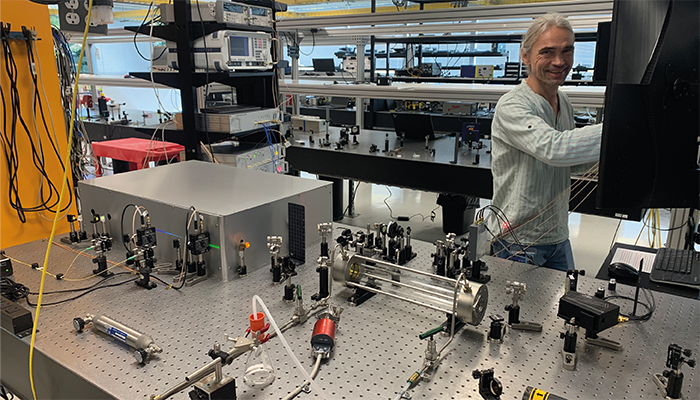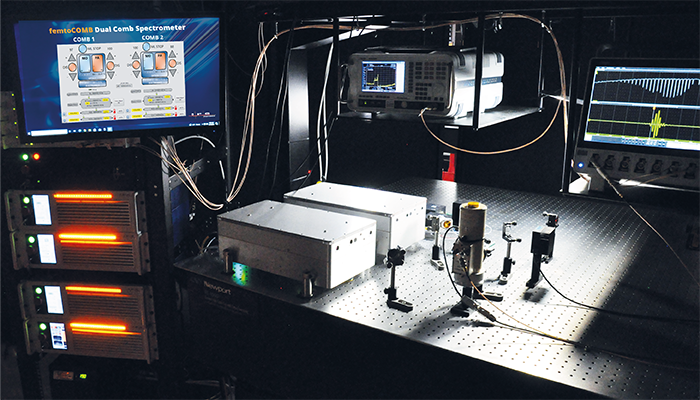
Mass Spectrometry and Infrared (IR) Spectroscopy are the preferred analytical techniques to identify and quantify unknown compounds. IR optical measurements are often easier and faster, yet mass spectrometry remains the gold standard for chemical analysis, especially for identifying low concentrations of unknown chemicals.
However, since the 2005 Physics Nobel Prize recognized John Hall and Theodor Hänsch’s development of laser-based precision spectroscopy based on optical frequency combs (OFC), the extension of the concept to dual OFC’s (1) and the first experimental demonstration (2), efforts gathered steam to realize fast, sensitive, and broadband IR spectrometers. We believe that OFC-based instruments are now poised to realize this potential – complementing and, in some applications, replacing mass spectrometry as the tool of choice.

Today, mass spectrometry delivers best-in-class sensitivity. That technique splits samples into ionized fragments, then separates the fragments based on their mass-to-charge ratio to produce signatures that are interpreted to identify molecular weights and structures, as well as that of the original compound. But mass spectrometry has tradeoffs in terms of cost, complexity, and throughput.
Fourier Transform Infrared (FTIR) spectroscopy, on the other hand, is more reasonable cost-wise, and with a broad spectral range. In FTIR, broadband infrared light interrogates a sample by interacting with the vibrational and rotational modes of the constituent molecules. Because FTIR is non-destructive, it avoids the ambiguity associated with interpreting mass spectrometry data. Until recently, the lack of bright infrared sources and the associated need for mechanical scanning limited the speed, resolution, and sensitivity of common FTIR instruments. Quantum Cascade Lasers (QCL) solve the brightness issue, offering high speed measurements with excellent resolution. But a QCL can only be tuned over a narrow (a few microns) wavelength range. Enter OFC, which combines broad wavelength coverage across the full molecular fingerprint region with the high brightness of a laser.
Last year, Professor Vodopyanov’s team at the University of Central Florida demonstrated, using a commercially available mid-IR dual OFC laser source, molecular spectroscopy with unprecedented resolution and dynamic range (3). Their study reveals for the first time in full detail the Doppler-limited spectroscopic signatures of a mid-sized molecule at low pressure. Traditional FTIR lacks the resolution and dynamic range to capture such detail. In contrast, the intense, broadband illumination, high resolution, and high dynamic range detection of the dual OFC spectrometer is capable of revealing the new spectral information. Compared to traditional FTIR, the UCF results are the spectroscopic equivalent to trading in a pair of binoculars for the James Webb Telescope.
In October 2024, Konstantin Vodopyanov’s unveiled his team’s latest results on extending the use of dual-comb spectroscopy (DCS) to the UV: showcasing an ultrafast laser platform capable of generating stable and reliable ultra-broadband optical frequency combs in the UV, with a line spacing of just 80 MHz and a resolving power of up to 10 million.
In Dual-comb spectroscopy, two frequency combs are combined onto a single detector to produce interferograms, before performing a Fourier transform to reconstruct the entire spectrum. To demonstrate the power of their system, the researchers at UCF measured the narrow reflection spectrum of a UV volume Bragg grating.
“Broadband, high-resolution UV spectroscopy provides unique insights into electronic transitions in atoms and molecules, making it invaluable for applications such as chemical analysis, photochemistry, atmospheric trace gas sensing and exoplanet exploration, where the simultaneous detection of numerous absorption features is essential,” said Vodopyanov in a press release. The team believe they have developed the first example of ultra-wideband DCS performed in the ultraviolet range at such high resolution.
In addition to unprecedented sensitivity, dual OFC spectrometers capture data in real-time. The video below shows a testbed integrating a dual OFC laser with a multi-pass gas cell. When methanol gas enters the cell, the oscilloscope immediately displays the captured spectrum, including fine structures that a less sensitive technique is unable to resolve.
Equally promising, the hybrid fiber/solid-state laser source incorporates mature, robust technologies, with the addition of proprietary crystals to provide its unique mix of watt-level broadband mid-IR light with ultra-low noise. A commercially available mid-IR dual OFC laser source (see above) already fits on a tabletop. As with other fiber-based laser technologies, ongoing optimization and cost-reduction will enable the platform to shrink further in both size and cost, allowing fast, ultra-sensitive broadband dual OFC laser spectrometers to proliferate.
Dual OFC’s newfound ability to make fast, broadband, high resolution, high dynamic range optical measurements is an exciting development for the analytical science community – promising to extend the application space of IR spectroscopy into areas dominated by mass spectrometry. Affordable, compact dual OFC spectrometers may even enable new applications, such as real-time point-of-care breath analysis for disease diagnosis and monitoring, real-time fence-line emissions monitoring, and standoff detection and analysis of trace chemicals.
Image Credits: Supplied by Author
References
- S. Schiller, "Spectrometry with frequency combs," Opt. Lett., 27 (2002).
- Keilmann et al., "Time-domain mid-infrared frequency-comb spectrometer," Opt. Lett., 29 (2004).
- Konnov et al., “High-resolution frequency-comb spectroscopy with electro-optic sampling and instantaneous octave-wide coverage across mid-IR to THz at a video rate,” APL Photonics, 8, 110801 (2023). DOI: 10.1063/5.0165879.




